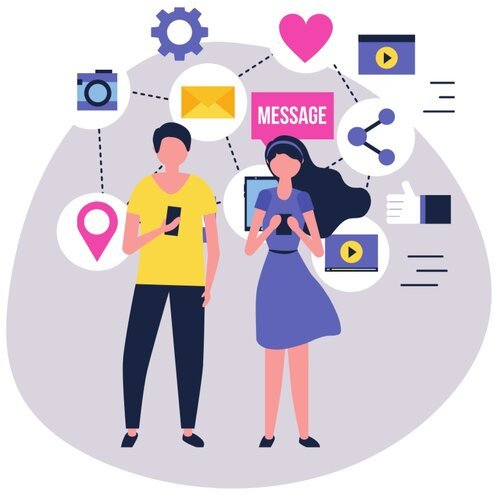THE CIRCLE
Microsoft Switzerland will soon be moving into the CIRCLE at the airport Zurich. There is plenty of open space and collaboration rooms of all sizes for the approximately 400 employees in the Zurich region. Classic focus workstations, on the other hand, are down to 88. Hybrid working is no longer a vision of the future. We spoke with Marc Holitscher, National Technology Officer at Microsoft Switzerland, about the hybrid future. This much is certain: we have a unique opportunity to completely rethink the way we work now.
Marc Holitscher, National Technology Officer at Microsoft Switzerland
Mr. Holitscher - around 400 of Microsoft Switzerland's 600 employees will soon be moving into the CIRCLE. What awaits them?
Not a place to write emails or make phone calls, but a place to meet and innovate.
Microsoft has been using remote work principles since 2012. Already in Wallisellen, the focus was on communal spaces. What is different in the CIRCLE? Had the pandemic led to short-term changes in the room design?
We have rented another 1,000 m² for the Microsoft Technology Center, which will open its doors in January 2022. There we want to meet with customers to discuss new technologies and bring them to life.
70 percent of our office space in the CIRCLE is also open to our partners and customers. We want to come into the office to innovate together. This trend has intensified once again. In Wallisellen, there were 290 focus workplaces. In CIRCLE, there are still 88.
A clear sign that physical presence is not required for employees.
Yes. With us - with a few exceptions - no one has to be on site. The individual teams should organize among themselves - in a way that it's right for the customer, but also for each individual team member. Studies show that people do want to get together. We want to offer attractive opportunities for this in our space in the CIRCLE.
You address the paradox that Microsoft's annual Work Trend Index highlights: 71 percent of the Swiss employees surveyed would like the hybrid work model, and over 70 percent would like to spend more time physically with their teams. Does Microsoft already have answers to this?
Technology makes many things possible. The experience of hybrid meetings, for example, is improving continuously - with Microsoft Teams, but also thanks to modern infrastructure in meeting rooms. Speakers and cameras automatically focus on the person who is speaking. The meeting rooms here at CIRCLE have been designed and equipped to ensure an optimal meeting experience for people on-site and virtually.
Technology allows for flexibility. Spaces can be customized. We should use that to our advantage - for the well-being of employees as much as for the long-term success of the company.
Since the pandemic, Microsoft Teams is probably as well known to typical Swiss citizens as Migros or Coop. What do you make of it?
We're enormously proud that we've been able to empower so many people to use Teams to continue working, continue their studies, or simply stay in touch with family and friends. At the same time, it was and is a huge responsibility and a real stress test for the system. The good news: our data centers passed the test. The enormous and rapid demand could not have been cushioned with any other infrastructure. It is gratifying to see that more and more companies are making use of the benefits of the Microsoft Cloud in Switzerland and that Microsoft Teams is becoming the center of everyday work.
“The hybrid is a reality. People want to work this way. We have a unique opportunity to completely rethink the way we work now.”
Technologically, some Swiss companies have made a leap forward. They have brought their infrastructure up to date. But Microsoft also often talks about culture. The new Microsoft Technology Center wants make technology tangible. After infrastructure, where do CH companies still have the most catching up to do in order to successfully create a hybrid working model?
At Microsoft, we live in a kind of bubble in terms of technology. At many companies, there are still people who don't have mobile devices. No webcams. That's where we're in a very privileged situation at Microsoft. We have and get everything to fully embrace the hybrid work model.
We think the 3 Ps are paramount for a hybrid future.
PEOPLE: People need to understand and be able to assess how they can use technology to improve things for themselves. This requires regular education and training.
PLACES: Spaces need to be redesigned to serve different purposes and new needs.
PROCESS: Every single process, no matter how small, must be put to the test and rethought.
For example, how will we handle confidential documents that exist only on paper in the future? Can confidential documents be taken home? How do we ensure that we get the necessary signatures for contracts when not everyone is working on site anymore?
We have a unique opportunity to completely rethink the way we work now. The hybrid is a reality. People want to work this way - for Generation Z, anything else would be unthinkable.
Jedes Unternehmen braucht jetzt einen genauen Plan, wie man in Zukunft physisch und digital verbindet. Aber wir brauchen dafür auch die richtigen regulatorischen Rahmenbedingungen, die es uns ermöglichen, modernste Technologien einzusetzen. Die heutigen Gesetze wurden teils vor der Internet-Ära gemacht. Auch sie müssen neu gedacht werden. Dies soll verantwortungsvoll und keinesfalls auf Kosten von nicht verhandelbaren Werten wie Transparenz, Sicherheit oder dem Schutz der Privatsphäre geschehen.
Wir bei Microsoft sind digitale Optimisten. Wir glauben daran, dass sich eine hybride Welt schaffen lässt, in der wir erfolgreicher zusammenarbeiten und besser leben.

















